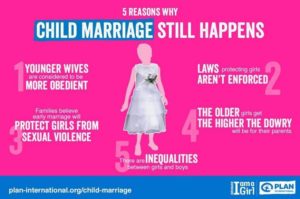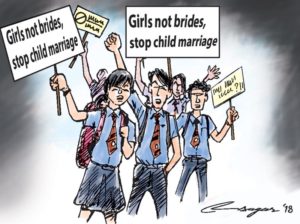
Table of Contents
Definition of a Child:
- The United Nations Convention on the Rights of the Child (UNCRC) defines child as “a human being below the age of 18 years unless under the law applicable to the child, majority is attained earlier”
- Simply understanding, any person below the age of 18 years is considered as a child.
Child Marriage:
- Child marriage is defined as a marriage of a girl or a boy before 18 years of age.

- Child marriage refers to both the formal marriage or informal union (living with a partner as if married) between the children of 18 years of age.
- CHILD MARRIAGE ENDS CHILDHOOD.
- Child marriage is a global issue fueled by gender inequality, poverty, social norms and insecurity.
- Child marriage disrupts children’s right and places them in high risk of violence, exploitation and abuse.
- Child marriage has devastating impacts all over the world.
- It negatively influences children’s rights to education, health and protection.
- There are many factors that interact to place a child at risk of marriage.
- Child marriage is also a result of interplay of social and economic forces.
Key Facts About Child Marriage:
- Globally, more than half a billion girls and women alive today were married in childhood.
- About 34% and 28% of young women in Sub-Saharan and South Asia respectively were married in childhood. This is a very high number.
- In the Middle East and North Africa, there has been substantial progress in reducing the prevalence of child marriage made over the past 25 years, but progress appears to have slowed within the last decade
- About 40 million girls ages 15-19 are currently married or in a union worldwide.
- Each year, some 12 million more girls will marry before reaching age 18 – and of those, 4 million are under age 15.
- By 2030, it’s estimated that 150 million girls will lose their childhoods due to child marriage.
- In Latin America and the Caribbean, there has been no significant change within last 25 years in child marriage.
- In contrast, a girl’s risk of marrying in childhood in South Asia has declined by more than one third, from nearly 50 percent a decade ago to 28 per cent today.
- However, the global burden of child marriage is shifting from South Asia to Sub-Saharan Africa, where levels of child marriage have only declined at a modest rate
- The COVID-19 pandemic has profoundly affected the everyday lives of girls.
- Assumptions are made that, as a result of the pandemic, over the next decade, up to 10 million more girls will be at risk of becoming child brides.
- Sustainable Development Goal (SDG) states to end child marriage by 2030. But due to the pandemic, the obligation has extended to 10 million more girls whose life is in jeopardy along with 100 million girls who were at risk of becoming bride before the pandemic.
- The marriage of older adolescent girls aged 15-18 is however still commonplace, so more efforts are needed to protect them.
Causes of Child Marriage:

- Poverty
- Gender discrimination
- Tradition and culture
- Inadequate laws
- Poor implementation of laws
- Lack of awareness
- Insecurity of their daughter’s future
- Perceived low status of girls
- Lack of education
- Safety concern over girl children and control over their sexuality
- Lack of awareness of the laws against child marriage
- Dowry system
- Pressure of the society
- Considering girls as a household helper
- Insecurity during war and conflict
- Lack of education and job opportunities for girls
Consequences of Child Marriage:
Although child marriage is applicable to both the boys and girls, its implications are prominent and disproportionate on the girls as compared to boys. The major consequences of child marriage, particularly to the girls, are:
Consequences on Health
1. Physical consequences
- Premature pregnancy
- Higher risk of experiencing dangerous complications in pregnancy and childbirth
- Maternal and infant mortality
- Malnutrition
2. Psychological consequences
- Anxiety and stress (both girls and boys)
- Depression
Consequences on Education 
- Barrier to study
- Increases illiteracy
Consequences on Social Life
1. Human rights
- Violation against child and women rights
- Interrupts freedom and independency
- Girls cannot express their views and needs openly
2. Domestic life
- Increases poverty and can lead to intergenerational cycle of poverty
- Increases domestic violence
- More chances of sexual violence
Preventive Measures:

Different measures to prevent child marriage are:
- Educating and empowering girls as well as their parents
- Mobilizing and educating community
- Introducing new schemes and incentives for promotion of child and women lives
- Proactive role of media in enforcing laws
- Providing relevant economic support to the girl’s family
- Advocate for women as community leader
- Supporting anti child marriage charity and organizations
- Discouraging marriage registration for child marriages
- Strict law and punishment for those who force child to marry
- Creating environment to support child and women rights
- Promote evidence-based advocacy and programs.
- Develop a system to respond to the needs of an adolescent who is at risk of child marriage
- Awareness programs and interventions to shift social expectations relating to the girls
- Engaging men and boys in awareness programs related to child marriage
International Conferences and Conventions on Child Marriage:
1. Universal Declaration of Human Rights (UDHR) states child marriage is a violation of Article 16(2) which says “Marriage shall be entered into only with the free and full consent of the intending spouses.”
2. Convention on the Elimination of all Forms of Discrimination Against Women (CEDAW) often referred as women’s bill of rights states that women should have the same right as men to “freely choose a spouse and to enter into marriage only with their free and full consent”, and that the “betrothal and marriage of a child shall have no legal effect” in its article 16.
3. Convention on the Rights of the Child (CRC): In signing the Convention on the Rights of the Child (CRC), governments also committed to take “all effective and appropriate measures with a view to abolish traditional practices prejudicial to the health of the children,” 3 which includes, among other practices, female genital mutilation/cutting and child marriage.
4. Convention on Consent to Marriage, 1994 has set the minimum age limits for marriage and marriage registration to be mandatory
5. International Conference on Population and Development (ICPD): In a landmark international consensus, the Programme of Action adopted by the ICPD in 1994, countries agreed on measures to eliminate child marriage as well as to “strictly enforce laws to ensure that marriage is entered into only with the free and full consent of the intending spouses”
6. Sustainable Development Goal (SDG): The elimination of child marriage by 2030 is a target under the Sustainable Development Goals (SDGs).
References and For More Information:
https://data.unicef.org/topic/child-protection/child-marriage/
https://www.ohchr.org/en/professionalinterest/pages/minimumageformarriage.aspx
https://nepal.unfpa.org/en/node/15217
https://www.unfpa.org/child-marriage-frequently-asked-questions
https://learning.nspcc.org.uk/child-protection-system/children-the-law
https://www.unicef.org/child-rights-convention/convention-text-childrens-version
https://www.unicef.org/india/what-we-do/end-child-marriage
https://www.savethechildren.org/us/charity-stories/child-marriage-a-violation-of-child-rights
https://www.unfpa.org/child-marriage-frequently-asked-questions